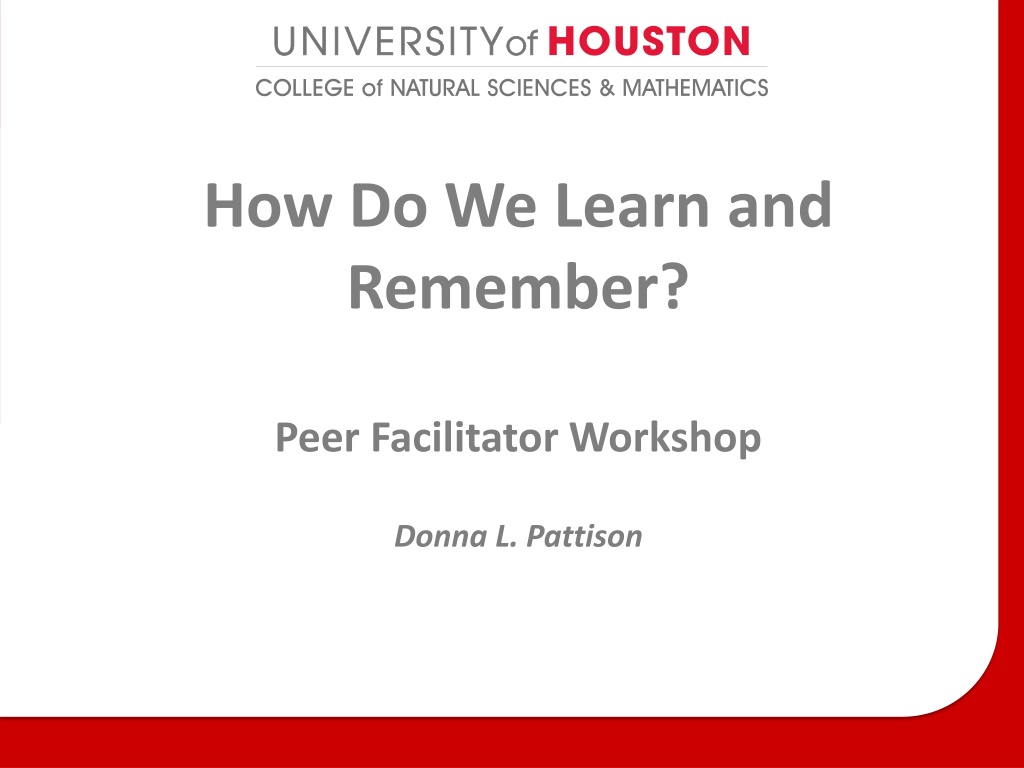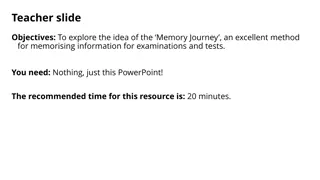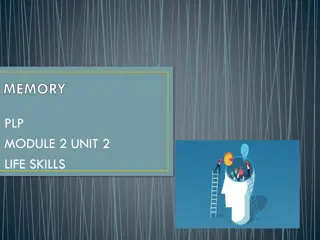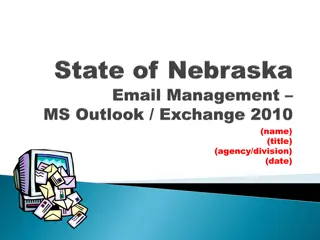Effective Strategies for Learning and Memory Retention
Explore techniques for enhancing learning and memory retention, including the role of brain plasticity, repetition, and rehearsal. Key points cover the importance of spacing out practice, cumulative tests, reflection, explaining concepts, and utilizing visual aids. Discover methods like flashcards, outlining, and concept maps to promote repetition and elaboration in learning.
Download Presentation

Please find below an Image/Link to download the presentation.
The content on the website is provided AS IS for your information and personal use only. It may not be sold, licensed, or shared on other websites without obtaining consent from the author. Download presentation by click this link. If you encounter any issues during the download, it is possible that the publisher has removed the file from their server.
E N D
Presentation Transcript
How Do We Learn and Remember? Peer Facilitator Workshop Donna L. Pattison
Learning causes brain cells. Dentrites grow as neurons are repeatedly activated. High levels of neurotrophins in actived brain areas. Levels highest in childhood. https://www.ninds.nih.gov/Disorders/Patient-Caregiver-Education/Life-and-Death-Neuron, retrieved 10/26/2017
The Brain is Plastic! http://www.google.com/imgres?imgurl=&imgrefurl=http%3A%2F%2Fmva.me%2Feducational%2Fbrain_areas.html&h=0&w=0&sz=1&tbnid=8ycD_26 Kxm9ZPM&tbnh=196&tbnw=257&zoom=1&docid=BLB1yIjmhM58UM&ei=axMNUtrkFaG4yQHwj4DQCQ&ved=0CAIQsCU
Use it or lose it.. Visual Cortical growth .and then .. Nature, 2004 Pruning
Without repetition and rehearsal, we forget! http://thinkedu.net/blog/wp-content/uploads/2015/12/Memory- Retention-and-the-Forgetting-Curve-Infographic.png; retrieved 10/26/2017)
Enhancing Long-Term Recall 1. Space out practice time. Cramming doesn t work. 2. Cumulative tests or exams (repetition and improved connections between early material in a course and later material). 3. Reflection (Increases the number of connections students make between new learning and prior knowledge. Creates an additional memory path). Ask how they can use the knowledge to solve other problems or apply the knowledge. Strengthens memory and deepens understanding. 4. Explain in your own words. Personal language is the most familiar pattern to students. 5. Visual information.
What are ways to generate repetition and elaboration? https://www.ninds.nih.gov/Disorders/Patient-Caregiver-Education/Life-and-Death-Neuron, retrieved 10/26/2017
What are ways to generate repetition and elaboration? 1. Flashcards 2. Outlining 3. Concept Maps 4. Answering questions at the back of chapters or within chapters. 5. Explaining a concept to someone else. 6. Reviewing notes and study tools. 7. Practice tests. 8. Videos on the topic. Can you think of any other methods to recommend to your students?
You have 1 minute to memorize the next slide ..
http://www.abc.net.au/radionational/programs/scienceshow/testing-the-effect-of-colour-http://www.abc.net.au/radionational/programs/scienceshow/testing-the-effect-of-colour- on-the-ability-to-memorise/4545604
Now write down all the words you can remember.
Use some metacognition here. How did you think about this task? 1. How many words did you remember? 2. What tricks or mneumonic devices did you use to help remember the words? Color Make sentences out of the words Make sentences out of the first letter of words Turn the words into a story Others? 3. What can you take from this exercise to teach your students how to master course material?
Remember this childhood game? Think about how you think to win. What do you do? http://di1-2.shoppingshadow.com/images/pi/52/05/9a/96728429-260x260-0- 0_Hasbro+Boohbah+Memory+Game.jpg
How about this game? Think about how you think to win. What must you do? http://www.infmetry.com/wp-content/uploads/2010/07/Memory-Game-Alarm- Clock-cool-gifts.jpg
You have 30 seconds to memorize this DOENSFTHECBNIHNASANSFNOAA
Write down what you remember
DOE NSF THECB NIH NASA NSF NOAA 1. How many letters did you remember? 2. What tricks or mneumonic devices did you use to help remember the words? Recognized a few of the acronyms Make sentences out of the first letter of words Turn the letters into a story Chunking into 3 or 4 letter clusters Other methods? 3. What can you take from this exercise to teach your students how to master course material?
You have 30 seconds to memorize this MDFLOHHIMNNHVAPALATXCOCANCDENJTN
MD FL OH HI MN NH VA PA LA TX CO CA NC DE NJ TN We recognize the patterns easily when we understand the meaning.
You have 10 seconds to memorize this 417625278
417-62-5278 Three pieces of information instead of 9
Patterns: If you understand the organization, it makes sense! A few things to remember rather than 118 .
Other Useful Patterns in Mastering Material Similarity and Difference Compare and Contrast Cause and Effect Hierarchy Alphabetical Order Chronological























